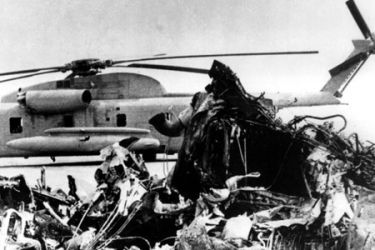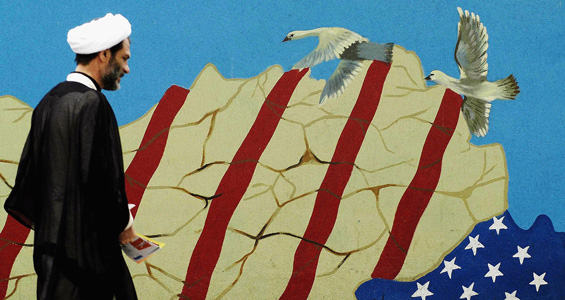Remembering Operation Eagle Claw
Former CIA official says failed rescue mission offers lessons for current US-Iran relations.

 |
| In 1979, Iranian students stormed the US embassy, taking 52 Americans hostage [GETTY] |
When I think back to April 25, 1980, I think of the reactions of a callow young man and his friends to the news which was rapidly filtering out on that bright spring morning, some 30 years ago.
The initial reports told of the calamitous failure of a clandestine mission, launched the day before by the US military and the CIA, to rescue 52 American diplomats held hostage by militants loyal to the nascent revolutionary government being set up in Iran by Ayatollah Khomeini.
Operation Eagle Claw had been aborted when three helicopters launched from the aircraft carrier Nimitz had either been heavily damaged or forced to return when they encountered a sandstorm en route to their rendezvous point at Desert One, deep in the deserts of Yazd Province.
Left with just five helicopters to pursue the planned rescue, the force commanders had to abandon the operation.
Simple failure turned to ignominious debacle, however, when an attempt to refuel some of the aircraft at Desert One produced a disastrous crash and fire, resulting in the destruction of a C-130 aircraft and a helicopter, the deaths of 8 servicemen, and serious injury to several more.
Their position compromised, the force made a hasty evacuation, leaving the charred bodies of several of their dead comrades behind.
Timid and ill-informed
Barely out of training, I and my young CIA friends had known nothing about the preparations for this operation.
We were young and confident, though, and seized by the global power and responsibilities of the country we were so eager to serve.
Eager to get our hands on some of that power, we closely watched our elders and betters in those days for any sign of weakness or lack of resolve, secretly convinced that where they might be lacking, we no doubt could and would do better.
We were surprised not just by the failure of this operation, but indeed that it had been attempted at all.
Many in our group saw the administration of Jimmy Carter as weak and vacillating; we did not anticipate that they would have had the audacity to attempt such a rescue.
Nonetheless, we were as quick to conclude that the mission’s failure was due to just such a lack of confidence and resolve.
The fact that the mission’s cancellation could have been forced by the mechanical failure of just three helicopters indicated to us that timid and ill-informed politicians had tried to limit the scale of the mission to such an extent that any slight setback would doom it to failure.
National humiliation
| IN depth | |||||||||||||||||||||
|
The failure of Operation Eagle Claw was seen as a national humiliation at the time.
I remember well the rage and revulsion with which Americans responded to the ghoulish Ayatollah Khalkhali as he was photographed desecrating the bodies of dead Americans at Desert One.
In the post-mortem investigations which followed, many weaknesses of operational coordination were discovered, which led to sweeping reforms within the US military.
As I look back now, however, with the benefit of 30 years of experience, my reactions are quite different from those which animated me and my friends so long ago. And while the assessments of the operational failures which led to the debacle at Desert One were no doubt valid, I doubt that these were the most profound conclusions one could reach.
With the benefit of the detailed histories which have been publicly revealed since that time, I am amazed at the complexity and sheer audacity of the operation.
Given the dozens of things which could easily have gone wrong had Operation Eagle Claw been properly launched from the remote base, one can only contemplate the even greater disasters which might well have befallen the rescuers and the nation which launched them.
What if the large American rescue team had been compromised and captured in Tehran?
What if their attempted rescue had resulted in the injury or deaths of many of the hostages themselves?
Dozens, perhaps hundreds, of Iranian civilians might well have been killed by the US gunship assigned to cover the planned evacuation of the hostages and their rescuers from a stadium across the street from the US embassy, had they poured into the streets in response to the commotion.
And even if the operation had defied the odds and succeeded flawlessly, what would have been the global impression of a great power forced to engage in subterfuge in answer to what most would consider a highly public act of war?
Political pressure
 |
| The C-130 aircraft and helicopter crashed in the desert while attempting to refuel [AP] |
What seizes me now is not the operational failings which led to humiliating disaster, but speculation over what must have motivated Carter and his advisors to take such huge, ill-advised risks in the first place.
I was not a participant then in the councils of government with which I was to become so familiar later, in the context of very different crises. But my experience has underscored the truth of the old adage that “all politics is local”.
My strong suspicion is that the events of April 25, 1980 had more to do with US politics than they had to do with Iran.
By ill-advisedly pledging to remain at the White House until the hostages were recovered, and by inadvertently contributing to the political logic which made their rescue a litmus test of his leadership as president, Carter must have found himself subjected to excruciating political pressure by the spring of 1980.
Such pressure leads to the conclusion that one must do something, no matter how desperate, because the negative political consequences of doing nothing seem impossibly great.
It is that logic – the seeming imperative to do something – which leads to the willful suspension of ordinary calculation and which in turn makes colossal, ill-advised blunders possible.
It was the desperate desire to do something which led to the disastrous dispatch of Albanian anti-Communist partisans to their deaths in the 1940s, to the near-criminal encouragement of the Hungarian rebels in 1956, to the debacle at the Bay of Pigs in 1961. One could easily go on with this litany.
Risk versus gain
This is not an argument against the efficacy of covert operations as an instrument of foreign policy. Certainly, no one is going to get such an argument from me.
It is an argument, however, for the wise, objective, and dispassionate weighing of potential risk versus potential gain which must underlie any resort to force in foreign relations, whether overt or covert.
With that in mind, it is perhaps useful to consider the real lessons of Operation Eagle Claw in the context of the current crisis involving Iran: The international effort to preclude the clerical regime’s acquisition of nuclear weapons.
We can see the political pressures being ratcheted upward. We see the statements emanating from Tel Aviv, and the strident warnings on the editorial page of The Washington Post.
The Obama administration has stated clearly and repeatedly that Iranian development of a nuclear weapon – even the development of a nuclear weapons capacity – is “unacceptable”.
Each passing week makes it clearer that “crippling” international sanctions against Tehran are simply not on the cards.
What, then, can be the alternative? If the consequences of inaction are unacceptable, then must not the US do something?
This is not the place for an exhaustive examination of the risk versus gain calculations which ought to guide US and international policy vis-à-vis Iran.
As we look back at the disaster which transpired in the Iranian desert so many years ago, however, and examine the political calculus which may have precipitated it, we would do well to remember the hazards which can accrue when nations fall prey to the need to do something, for in these circumstances they become quite capable of doing anything.
Robert Grenier was the CIA’s chief of station in Islamabad, Pakistan, from 1999 to 2002. He was also the director of CIA’s counter-terrorism centre.
The views expressed in this article are the author’s own and do not necessarily reflect Al Jazeera’s editorial policy.